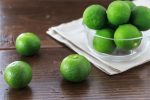Kabosu (Citrus sphaerocarpa Tanaka) is a citrus fruit widely grown in Japan. It is an ichang papeda – bitter orange hybrid.
The name kabosu originates in the Edo period (1603-1868) where the citrus peels were chopped up and used to fumigate for mosquitoes. The word for mosquito in Japanese is “ka”, and to fumigate is “ibushi”. This was contracted to “kabushi”, and then became “kabosu”. .
The fruit has an attractive and pleasant flavor, which has culinary uses in mainly Japanese cuisine. These include salad dressings and seasonings, especially in grilled seafood and hotpots, cooked fish and sashimi. It is sometimes used in ponzu juice where it accompanies the sudachi citrus fruit.
Production
Kabosu fruit is grown in Japan, mainly in the Oita, Aichi and Miyazaki prefectures. The general production level is about 8,000 tons in Japan.
References
Minh Tu, N. T., Onishi, Y., Choi, H. S., Kondo, Y., Bassore, S. M., Ukeda, H., & Sawamura, M. (2002). Characteristic odor components of Citrus sphaerocarpa Tanaka (Kabosu) cold-pressed peel oil. Journal of Agricultural and Food Chemistry, 50(10), pp. 2908-2913.


Interesting